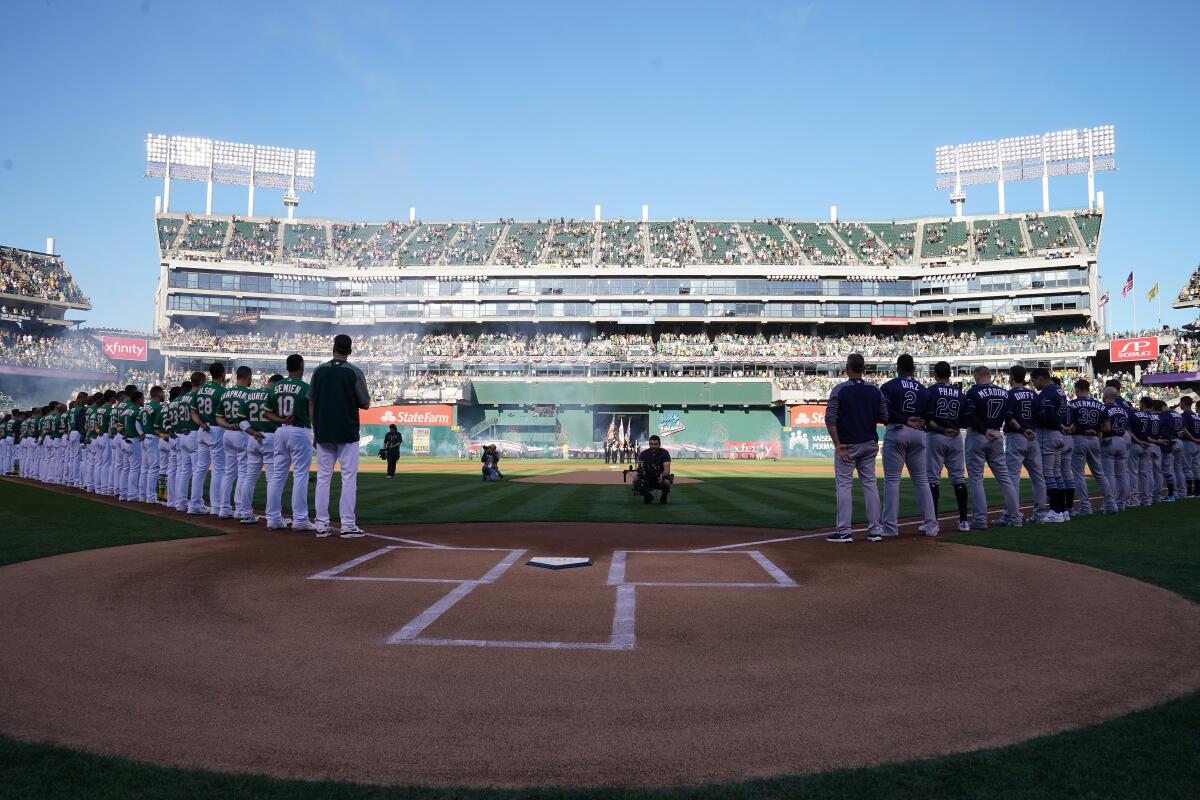A’s to Oakland City Council: Time to vote on our ballpark

For years, Major League Baseball Commissioner Rob Manfred has parried all inquiries about expansion or relocation with this response: We’ve got to resolve the ballpark situations with the Oakland Athletics and Tampa Bay Rays first.
Progress might finally be at hand.
On Friday, three years after proposing a waterfront ballpark in Oakland, the A’s put their financial cards on the table: a billion-dollar ballpark, privately financed, with an additional $450 million in community benefits, including affordable housing. The project would include development of a neighborhood surrounding the 35,000-seat ballpark, similar to what the Angels have pledged to develop around Angel Stadium.
The A’s ask the city to pay $855 million in infrastructure improvements, using taxes generated by the project. The A’s estimated total development costs for the project, in which they likely would partner with private developers, are $12 billion.
The Oakland Athletics badly need a new home.
In a letter released Friday, Oakland Athletics President Dave Kaval asked the City Council to vote on the project before the council recesses for the summer.
The A’s also would like the right to develop the Oakland Coliseum site, where they currently play and where the Golden State Warriors and Las Vegas Raiders used to play. The Coliseum site is not mentioned in the term sheet submitted by the A’s Friday. Kaval previously told The Times that the A’s could pay for the waterfront ballpark even if the city did not grant the team development rights to the Coliseum, although revenue from that development could help with private financing of the ballpark.
Oakland Mayor Libby Schaaf this month publicly threw her support behind the waterfront ballpark. However, in a statement Friday afternoon, Schaaf declined to commit to the amount of public funding the A’s are seeking or the timetable for city approval.
“The city is willing to bring to bear its resources to help make this vision a reality; however, today’s proposal from the A’s appears to request public investment at the high end for projects of this type nationwide,” Schaaf said. “We remain fully committed to working collaboratively with the A’s, our City Council, and our community partners, to formulate a public-private partnership and project of which we can all be proud, and to bring forth a consensus plan to our City Council this year.”
The project has faced community opposition from groups that believe the waterfront site is best used for port purposes, and others that believe the transportation hub at the Coliseum site makes it the logical place for the A’s to build a new ballpark.
The A’s have spent this entire century searching for a new home, with unsuccessful proposals in San Jose, Fremont, and multiple sites in Oakland along the way.
Ten former USC Song Girls described to The Times a toxic culture within the famed collegiate dance team that included longtime former coach Lori Nelson rebuking women publicly for their eating habits, personal appearance and sex lives.
In Florida, the Rays’ lease at the domed Tropicana Field expires in 2027. The Rays have refused to commit to privately financing a new ballpark, and they have floated a quixotic proposal to split the season: start in Florida, finish in Montreal. That would require two new ballparks, each used for a part-time tenant, without the Rays paying for either one.
The city of St. Petersburg this month retained a stadium consultant to negotiate with the Rays about staying, but also a real estate consultant to negotiate with potential developers for the Tropicana Field site, with or without the Rays.
More to Read
Go beyond the scoreboard
Get the latest on L.A.'s teams in the daily Sports Report newsletter.
You may occasionally receive promotional content from the Los Angeles Times.











